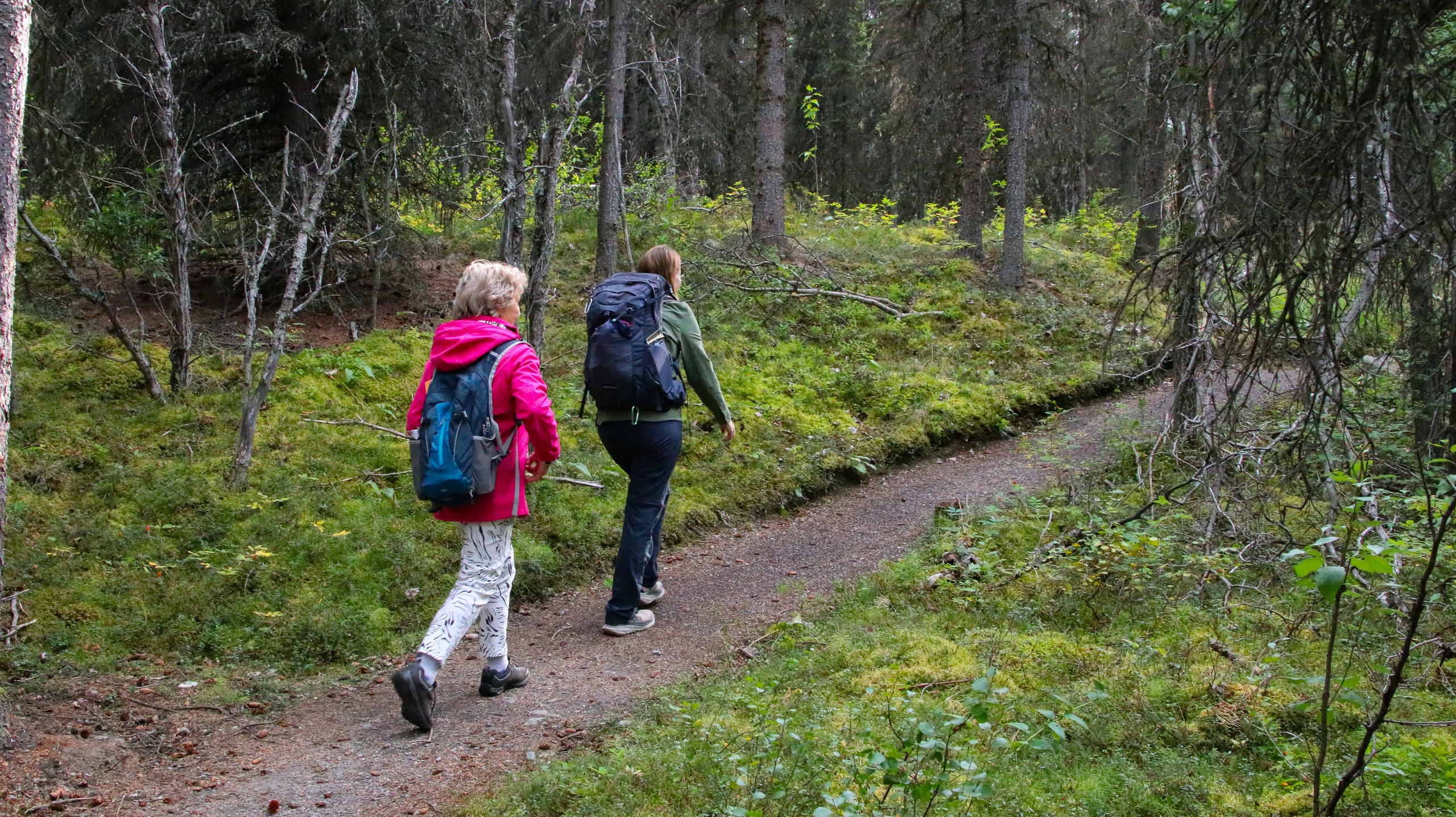Chasing Light in Denali: An Afternoon Hike Across Taiga and Tundra
Guided naturalist-led hike • Ages 5+ • 2–4 hours • Up to 5 miles round trip • Moderate to strenuous terrain
The day never seems to end this far north. By mid-afternoon, when most parks elsewhere are easing into golden hour, Denali still hums with a high, Arctic brightness, inviting you to lace up and step into its quiet. The trail starts under spruce and birch where the forest moves like a living thing—needles whispering, birch bark peeling in delicate curls, mosses breathing out the cool, loamy scent of the earth. Footsteps soften on duff. A hidden thrush throws its voice down the corridor of trees as if daring you to keep up.
Trail Wisdom
Layer for fickle skies
Weather can swing from sun to mist in minutes. Pack a breathable shell and a warm midlayer so you can adjust on the move.
Tread lightly on tundra
Step on rocks and durable surfaces when possible; tundra plants are tough but slow-growing and easily damaged.
Poles help on uneven ground
Trekking poles add stability on roots and tussocks and ease knees on descents.
Hydrate early and often
Bring at least 1–2 liters of water; cool air can mask dehydration, especially in steady wind.
Local Knowledge
Hidden Gems
- •Horseshoe Lake beaver-dam viewpoint near the park entrance
- •The Taiga Trail loop near the Denali Visitor Center for a quiet, interpretive stroll
Wildlife
Moose, Arctic ground squirrel
Conservation Note
Tundra vegetation grows slowly; stay on durable surfaces and give wildlife space (at least 300 yards for bears) to reduce impacts.
Established in 1917 and expanded in 1980, Denali National Park protects subarctic ecosystems long stewarded by Athabascan peoples.
Seasonal Guide
spring
Best for: Cool temperatures, Fresh wildlife sign
Challenges: Lingering snow/ice, Muddy trails
Early season brings crisp air and fewer visitors; expect patches of snow and wet, slick footing on shaded trail sections.
summer
Best for: Long daylight, Wildflowers and broad views
Challenges: Mosquitoes, Variable weather and wind
Peak season offers endless light and flourishing tundra blooms; carry bug protection and a windproof layer.
fall
Best for: Tundra colors, Cool, stable hiking temps
Challenges: Shortening daylight, Early frosts
Autumn paints the hills in reds and golds; start earlier to make the most of the light and prepare for chilly breezes.
winter
Best for: Solitude, Snowbound scenery
Challenges: Extreme cold, Limited access and services
Most guided hiking shifts to other activities; deep cold and reduced daylight demand winter-specific skills and gear.
Photographer's Notes
What to Bring
Waterproof shell (jacket and pants)Essential
Fast-changing weather and brisk winds make a breathable, rainproof layer indispensable.
Sturdy hiking boots or trail runnersEssential
Good traction and support help on roots, slick mud, and springy tundra.
Trekking poles
Useful for balance and knee support on uneven ground and short, steep pitches.
Insect repellent or headnet
Mosquitoes can be persistent in still air; be ready when the wind drops.
Common Questions
How far is the hike and how much will we climb?
Routes vary, but plan for up to 5 miles round trip with rolling elevation gains that can feel moderate to strenuous depending on the group and conditions.
Do I need to bring bear spray?
No. Your naturalist guide carries bear spray and is trained in wildlife safety protocols.
Is this hike suitable for kids?
Yes, ages 5 and up are welcome with the ability to hike 2–4 miles on uneven terrain. The guide will pace the day to the group.
What if it rains or gets windy?
Trips run rain or shine. Dress in moisture-wicking layers and bring a waterproof shell; wind is common on open tundra.
Are there restrooms on the trail?
Facilities are limited once you leave the trailhead. Use restrooms before departure and follow Leave No Trace practices if nature calls.
Do I need a Denali National Park pass?
Yes, a valid park pass is required. If you’re on a park bus tour, a weekly pass is typically included; otherwise purchase at the Visitor Center or online.
What to Pack
1) Waterproof shell: Keeps you dry when squalls roll through; 2) 1–2 liters of water: Cool air can mask thirst; 3) Warm midlayer (fleece): Tundra wind chills fast at overlooks; 4) Bug protection: Mosquitoes appear when the breeze settles.
Did You Know
At 20,310 feet, Denali is North America’s highest peak—and due to frequent cloud cover, only about 30% of summer visitors see the summit clearly.
Quick Travel Tips
Book lodging near the park entrance or in Healy for easy pick-up; Buy your Denali park pass in advance to save time; Expect limited cell service past the entrance—download maps offline; Start hydrated and eat a snack before the hike to keep energy up.
Local Flavor
After the hike, join locals at 49th State Brewing in Healy for halibut tacos and craft ales, or grab a slice at Prospector’s Pizzeria in Denali Park. If you’re craving something quirky and ultra-Alaskan, The Salmon Bake (“The Bake”) along the park strip dishes hearty fare and evening stories.
Logistics Snapshot
Closest airports: Fairbanks (120 miles) and Anchorage (237 miles). Trailheads vary near the Denali park entrance; most are a 5–15 minute drive from area lodges. Cell service is spotty to fair near the entrance and limited beyond. A valid Denali National Park pass is required; guided outings typically include hotel pickup.
Sustainability Note
Fragile tundra and permafrost define this landscape—stay on durable surfaces, pack out all trash, and give wildlife a wide berth. Following Leave No Trace here helps the subarctic recover from our footsteps.
Continue Reading

Canyon Wave: Rafting Denali’s Glacial Heart on the Nenana River
The Nenana River doesn’t whisper—it urges you forward. On the Canyon Wave run, you’ll punch through crisp, glacial rapids beneath Denali’s ramparts, trading roadside views for a front-row seat to Alaska’s wild hydraulics. Cold water, big smiles, and a canyon that knows how to keep pace.
Healy, Alaska

Chasing Light in Denali: An Afternoon Hike Across Taiga and Tundra
Trade the tour bus for tundra. This guided afternoon hike threads from shadowed spruce to open ridgeline, where Denali’s valleys breathe wide and the wind calls the cadence. Come for the views, stay for the stories beneath your boots.
Denali Park, Alaska
